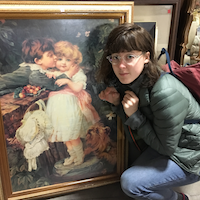More about The Crucified Christ
- All
- Info
- Shop

Contributor
Angolo Bronzino’s The Crucified Christ looks nothing like a typical crucifixion scene.
It doesn’t have any of the usual suspects: there aren’t any weepy saints hanging over Christ’s body; there isn’t a pastoral landscape receding into the distance; it isn’t gold (I’m looking at you, Middle Ages). By all accounts, this is your average, run-of-the-mill painting of a nearly-nude, muscular human body that just so happens to be crucified. But it certainly isn’t a Crucifixion scene as we typically know them.
Contrary to popular belief, not everyone who lived in 16th century Italy was a Catholic. Catholicism did, however, permeate society, and thus an artist working within these times would typically have no choice but to repeatedly paint religious scenes to please all of the rich patrons that wanted to display their virtue. Bronzino was perhaps one of the .00001% who didn’t believe in God and therefore tended to stray away from depicting religiosity in all of its ornate splendor. In fact, his Martyrdom of Saint Lawrence is often viewed as borderline heretical, as the main figure appears to be preparing for his glamour shot instead of his death via barbeque. For his Crucified Christ, Bronzino went so far as to strip the scene of anything remotely symbolic, leaving just one solitary figure in front of a somber architectural form that resembles a sculptural niche on the side of a church.
I have a hard time drawing things realistically from my imagination, which causes me to constantly look-up reference images on the internet. Bronzino, like me, preferred to paint from a model, however, he lacked the same 21st century luxury and therefore had a harder time finding something to reference. He wanted it to be realistic—so realistic that it’s almost as if he just nailed a cadaver to a board and called it a day. Oh wait...he did. The figure in the painting seems very lifelike, radiating a gentle luminescence instead of the cold, pallid appearance that eventually subsumes the body after death. Bronzino strove to render the exact moment of the Crucifixion and likely went through great lengths to achieve this, even if it meant procuring a fresh cadaver to observe. I'd say the scene turned out pretty believable, albeit a tad bit eerie.
Entering the Museum of Fine Arts Nice in 1879, this painting was originally thought to be the work of Fra Angelico. Once it was discovered that this was a misattribution, the painting became anonymous once more. On a visit to the museum in 2005, two art historians discovered—due to a "fortuitous ray of sunlight"—that it is indeed the work of Bronzino. Needless to say, it's a huge coup for this small little Nice-based museum.
Sources
- Glover, Michael. "Great Works: 'Crucified Christ' (circa 1540), Agnolo Bronzino." The Independent. https://www.independent.co.uk/arts-entertainment/art/great-works/great-…. (accessed March 27, 2
- Rykner, Didier "A Christ on the Cross by Bronzino Discovered in Nice." The Art Tribune. http://www.thearttribune.com/A-Christ-on-the-Cross-by-Bronzino.html. (accessed March 27, 2018)
- Morris, Roderick Conway. "Bronzino Emerges From Limbo." The New York Times. https://www.nytimes.com/2010/11/16/arts/16iht-conway.html. (accessed March 27, 2018)












